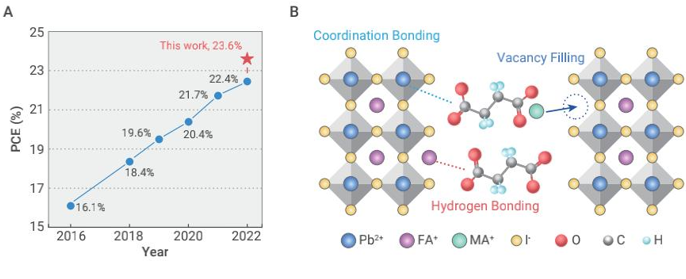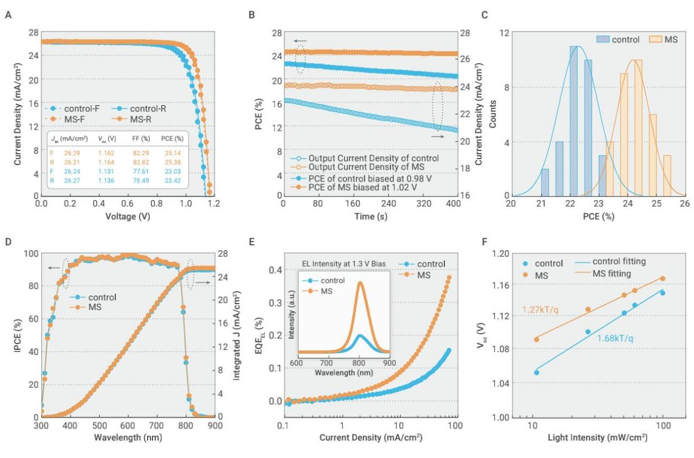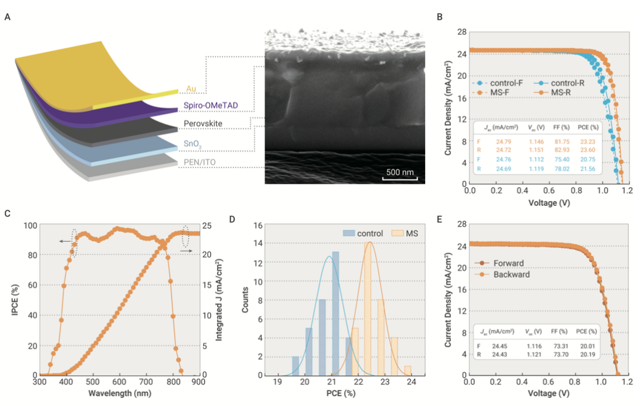Organic‒inorganic hybrid perovskite materials have the advantage of excellent light absorption and low processing costs. Flexible perovskite solar cells (FPSCs) prepared on flexible substrates, which possess excellent flexibility and a high power-to-weight ratio, hold promise as a power source for wearable electronic devices, spacecraft, and building integrated photovoltaics (BIPVs), and have received extensive attention from academia and industry specialists. Further improving the power conversion efficiency (PCE) and bending resistance of flexible devices is key to promoting their practical application.
Recently, Professor Chenyi Yi and his group from the Department of Electrical Engineering at Tsinghua University proposed a strategy to reduce defects and microstrains in perovskite films through multifunctional additives, achieving a record PCE of 23.6% for single-junction flexible perovskite solar cells (FPSCs).

Development of the efficiency of FPSCs and schematic diagram of the interacting mechanisms of multifunctional additives
In this work, the authors introduced a succinate additive into the perovskite precursor to improve the quality of perovskite films and the performance of perovskite solar cells. The carboxylic acid group in the succinate anion can interact with the formamidinium cation via hydrogen bonding, and can coordinate with the dangling lead atom in the perovskite lattice. Methylammonium cations can fill cation vacancies on the surface of perovskite grain. These various interactions lead to the suppression of defect states in the perovskite film and the relaxation of microstrains, resulting in a high-quality perovskite film for photovoltaic applications.
The perovskite solar cells prepared by this method showed excellent photovoltaic performance. A PCE of 25.4% was achieved for rigid PSCs under AM 1.5G standard illumination. The FPSCs fabricated on flexible substrates achieved the highest PCE of 23.6% (certified of 22.5%), which was both the highest efficiency record for single-junction FPSCs reported and certified thus far. Meanwhile, more than 20% PCE has been achieved for flexible devices with an aperture area of 1 cm2.
Apart from device performance enhancement, the addition of additives strengthens the grain of the film, which greatly improving the bending resistance of perovskite film. The flexible device still maintained 85% of the initial PCE after 10,000 bending cycles at a bending radius of 6 mm.

Effects of additives on the performance of perovskite solar cells (orange and blue represent samples with and without additives)

Device structure and optoelectronic properties of FPSCs (orange and blue represent samples with and without additives)
This work provides a new solution by using a multifunctional organic additive to strengthen the grain boundaries and heal defects in the perovskite film used for high-performance FPSCs. The excellent efficiency and bending resistance exhibited presents a promising future for FPSCs in practical application. We will further focus on module design and stability enhancement to promote the development and applications of FPSCs.
Reference:
https://www.sciencedirect.com/science/article/pii/S2666675822001060
Editor: Li Han

